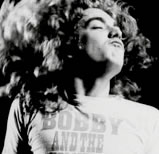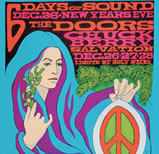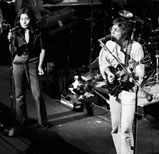
 |
On July 7, 1970, the rock band the Who played to a sold-out crowd at Tanglewood in the Berkshire Mountains of western Massachusetts. For more than 90 minutes they fired up the audience with a high-octane performance that included the hits “Pinball Wizard” and “We’re Not Gonna Take It” from the rock opera Tommy, as well as “My Generation.”
At the conclusion of the concert, promoter Bill Graham took the stage to thank the audience. He then encouraged them to sit back on the grass and relax because there was bumper-to-bumper traffic leaving the venue. He sheepishly asked them to please pick up some trash and throw it in a can on the way out so there would be less work for him and his crew.
The recording of that concert, with Graham’s words at the end, is one of the most played on the website Wolfgang’s Vault, an extraordinary collection of audio and video recordings from thousands of rock, blues, jazz, country, indie and pop concerts (including Robert Plant [below] and Led Zeppelin at the Newport Jazz Festival in Newport, R.I., in July 1969). Bill Sagan (WCAS73) purchased Graham’s archive, which includes mainly rock audio and video tapes and rare concert memorabilia, in 2002 and has been making the content available for purchase and streaming at the site. With 11 additional acquisitions of rock-related content, there are now more than 25 million items in the company’s three-story warehouse in San Francisco. “It’s more like a museum than a corporate headquarters,” says Sagan. “It’s tough to do your job because it’s so tempting to go down and just listen to the audio or go look at video.”
 Confidentiality agreements prevent Sagan from putting a price tag on the archives, but he says “various authorities have said that it may be worth more than $100 million.”
Confidentiality agreements prevent Sagan from putting a price tag on the archives, but he says “various authorities have said that it may be worth more than $100 million.”
“Sagan acquired the Bill Graham archive, and subsequent additions to his collection, with the kind of keen mind for investment opportunities that nobody in the almost all-amateur rock memorabilia circles ever saw before,” says author and San Francisco Chronicle senior pop music correspondent Joel Selvin. “In short order he amassed the single most impressive set of holdings in the field and made it clear he was not only a force to be reckoned with but a man with a vision for the future.”
Sagan was born in Cambridge, Mass. He and his four sisters grew up in a house where his parents “were music fans,” Sagan says, “mostly classical, Broadway and jazz.” Sagan was always a fan of rock ’n’ roll, starting with the Beatles.
At Northwestern, where he met his wife, Pam Kreml (WCAS73), he studied engineering for three years but ultimately graduated with a bachelor’s degree in political science. (Later their son Whitney (Mc06) and daughter Piper (C09) also attended Northwestern.) After earning an MBA from the University of Chicago, Sagan worked at IBM and then a capital equipment manufacturing and leasing company. He was chair and CEO of Trewit Inc., a managed health care and insurance company, from 1995 through 2002. When he sold the company, he turned his attention in a different direction.
“I have always believed that if you love running companies and are good at it, industry type is not a barrier,” says Sagan, a member of Northwestern’s Board of Trustees.

In 2002 an opportunity came his way that was too attractive to pass up. The archive of the concert production company Bill Graham Presents was up for sale. Sagan (above in the Wolfgang's Vault conference room in San Francisco) purchased it for less than $6 million.
Graham, whose real name was Wolodia “Wolfgang” Grajonca, was the foremost concert producer of his generation. From the mid-1960s until his death in 1991, Graham put on more than 30,000 concerts around the world. Nearly every major act played his concerts — Jimi Hendrix, the Grateful Dead, the Rolling Stones, Janis Joplin and Aretha Franklin, among others.
In addition to being a brilliant promoter, Sagan says, Graham “was a pack rat” who kept everything left over from his concerts — posters (such as the poster above advertising a Doors show at the Winterland Ballroom in December 1967), tickets, playbills, backstage passes, photographs, key chains and clothing. After purchasing the Graham archives, Sagan and his staff filled a San Francisco warehouse from floor to ceiling.
“We moved 26 40-foot-trailer loads to our building in San Francisco,” Sagan recalls. “Over the following two years we inventoried, counted, preserved, stored, did database entry and created our first version of the website. We always knew that our presence would be solely on the Internet and not in brick-and-mortar stores.”
Sagan knew he had something special, but it wasn’t until the inventory progressed that he realized exactly what he had. “We knew that the audio and audiovisual recordings were part of the purchase,” Sagan says. “We did not know until much later the extent of these recordings. And it was not until we began to transfer them from the original tapes into a digital format and could listen to them in depth that we realized the quantity and quality of these performances.”
That quality brings to life thousands of fabled concerts: Bob Dylan and the Band at the Forum in Los Angeles in 1974; Bob Marley and the Wailers in Oakland, Calif., in 1979; and the Allman Brothers at Fillmore East in New York City in 1971.

Visitors to the website can listen to and read about thousands of songs and concerts, most of them for free. The affiliated site Daytrotter is a music discovery site, where people come to learn about new bands. (Crawdaddy, the first rock music magazine, is also affiliated with the site.)
Since its debut in 2003 Wolfgang’s Vault has experienced remarkable traffic. The three sites together (Wolfgang’s Vault, Daytrotter and Crawdaddy) average 75,000 hits per day. More than 400 million songs have been streamed to listeners, the store has had more than 150,000 orders, and the site’s newsletter has 1.2 million subscribers.
The Vault Store is an eclectic collection of concert memorabilia. The set of vintage posters from the 1960s is especially appealing, with psychedelic, wildly colorful works by the top poster artists of that generation. The most expensive item from the store was a 1967 Hendrix poster that sold for $55,000. Vintage and retro T-shirts are available, as well as thousands of photos from the concerts (including the photo below of Yoko Ono, John Lennon and Frank Zappa at the Fillmore East in 1971).
In 2006 Wolfgang’s Vault was sued by Sony BMG and Warner Music Group and the Grateful Dead, Led Zeppelin, Santana, the Doors and the estate of Janis Joplin. The suit claimed that the website violated intellectual property rights by making available concert archives that belonged to the artists and by selling their merchandise. After two years of discovery, and before adjudication, the case was dismissed.
While much of the memorabilia collection is for sale, Sagan says there are some items that he will never part with. “We never sell the last two copies of any item,” he says. “In addition, we will never sell the massive door to Graham’s Winterland venue in San Francisco, our collection of Jimi Hendrix’s original song notes and his diary, original contracts, and any of Bill Graham’s personal items, including his 1,200-poster personal collection. We are a for-profit company, but we also have a very strong moral obligation to preserve this great art, photography and music.” Sagan says he has spent more than $9 million on preservation alone.
Sagan says that while most of the vintage memorabilia is already on the site, only a quarter of the audio recordings and just 1 percent of the video recordings have been catalogued and put into production.
“Live music is not sweetened, corrected, filtered, manufactured or manipulated like studio recordings,” says Sagan. “If you want to hear what the band played, unvarnished, come to Wolfgang’s Vault.”